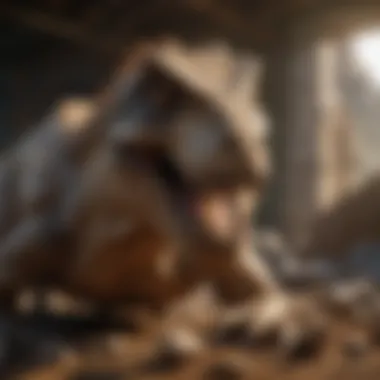Expert Guide: Tips for Buying Authentic Dinosaur Fossils


Rock and Fossil Identification
In the fascinating world of rock and fossil collecting, identifying different types of specimens is crucial. Rocks can range from sedimentary to metamorphic, each with distinct characteristics that reveal clues about their formation. Fossils, on the other hand, can be petrified remains of ancient organisms or imprints left in rock formations over millennia. When it comes to authenticating these treasures, collectors must look for specific markers such as fossilized bones, shells, or plant imprints. Utilizing tools like magnifying glasses, UV lights, and hardness testers can aid in the identification process, allowing collectors to delve deeper into the origins of their prized specimens.
Collecting Tips and Techniques
For aspiring rock and fossil collectors, mastering the art of hunting for these prehistoric remnants is a thrilling endeavor. Best practices involve thorough research to pinpoint prime collecting sites rich in geological history. Whether scouring coastal cliffs for marine fossils or exploring ancient riverbeds for hidden gems, enthusiasts must tread carefully while extracting specimens to preserve their integrity. Utilizing specialized excavation tools like chisels, brushes, and rock hammers ensures safe extraction without damaging the delicate structures within the rocks and fossils.
Preservation and Display
Once the treasures have been unearthed, the next challenge for collectors lies in preserving and showcasing their remarkable finds. Employing preservation techniques such as sealing fossils in protective agents to prevent deterioration and storing rocks in stable, controlled environments can prolong the lifespan of these invaluable artifacts. When it comes to displaying these geological marvels, creativity knows no bounds. From elegant shadow boxes highlighting intricate details to innovative mounting techniques that bring fossils to life, collectors can turn their passion into visually captivating exhibits that showcase the beauty and significance of their discoveries.
Geological Insights
Beyond the sheer excitement of collecting, delving into the geological aspects of rocks and fossils unveils a whole new realm of knowledge. Understanding the formations and processes that shaped these geological wonders provides insight into Earth's rich history, highlighting the evolution of landscapes over millions of years. From exploring the historical significance of key fossil discoveries to marveling at the intricate details preserved in ancient rocks, enthusiasts are transported back in time to witness the gradual transformations that have shaped our planet. With each discovery offering a window into the past, rock and fossil collectors embark on a journey of scientific discovery and appreciation for the mysteries that lie waiting to be unearthed.
Introduction
In the world of rock and fossil collecting, the allure of owning a piece of prehistoric history is undeniable. This article serves as a comprehensive guide for individuals intrigued by the idea of acquiring a dinosaur fossil for their collection. Whether you are a seasoned collector or a novice enthusiast, understanding the intricacies of purchasing a dinosaur fossil is paramount. From unraveling the importance of authenticity to navigating through the maze of reputable sellers, this guide covers all the critical aspects essential for a successful dinosaur acquisition.
Understanding the Appeal of Dinosaur Fossils
The Fascination with Prehistoric Creatures
The fascination with prehistoric creatures, particularly dinosaurs, stems from the mysteries of the ancient world they represent. These magnificent creatures have captivated human imagination for centuries, fueling curiosity about life on Earth millions of years ago. The allure of owning a piece of this history through a dinosaur fossil is a unique and thrilling experience for rock and fossil collectors. The tangible connection to a bygone era, preserved in the bones of these behemoths, adds a sense of wonder and intrigue to any collection, making them highly sought-after pieces among enthusiasts.
Educational and Decorative Value
Dinosaur fossils not only hold immense aesthetic appeal but also serve as invaluable educational tools. They offer a tangible representation of the Earth's history, allowing enthusiasts to study and appreciate the evolution of life on our planet. Beyond their educational significance, dinosaur fossils also hold substantial decorative value. Elegantly displayed, these fossils can become focal points in homes or museums, sparking conversations and awe in observers. Their dual role as both educational tools and aesthetically pleasing decor items makes them a versatile and enriching addition to any rock and fossil collection.
Importance of Due Diligence
Avoiding Counterfeit Items


One of the critical aspects of purchasing a dinosaur fossil is the need to avoid counterfeit items. As the demand for these relics grows, so does the risk of encountering fraudulent or misrepresented specimens. Conducting thorough research and scrutinizing potential purchases for telltale signs of forgery is essential for ensuring that you acquire a genuine dinosaur fossil. By understanding the distinct features that differentiate authentic fossils from counterfeit ones, collectors can protect themselves from falling victim to dishonest sellers and maintain the integrity of their collections.
Ensuring Legal Compliance
In the realm of acquiring dinosaur fossils, legal compliance is paramount. Due to the sensitive nature of paleontological finds, collecting and trading fossils may be subject to regulations and laws aimed at preserving cultural heritage and scientific knowledge. Ensuring that your purchase aligns with established legal frameworks not only safeguards you from legal repercussions but also contributes to the ethical and sustainable practice of fossil collecting. By adhering to legal guidelines and obtaining necessary permits or documentation, collectors uphold the integrity of the fossil market while responsibly engaging in the preservation of our planet's prehistoric legacy.
Researching Your Purchase
When delving into the world of buying a dinosaur fossil, conducting thorough research is paramount for a successful acquisition. Understanding the significance of researching your purchase within the context of this comprehensive guide is pivotal. By focusing on specific elements such as identifying authenticity markers and exploring reputable sellers, collectors can navigate the intricate process with confidence. Researching your purchase not only ensures the credibility of the specimen but also aids in making informed decisions that align with your collecting goals and budget.
Identifying Authenticity Markers
Key Features of Genuine Dinosaur Fossils
The key features of genuine dinosaur fossils play a critical role in verifying the authenticity and value of a specimen. These distinctive characteristics, such as fossilized bone structures, unique patterns, and consistent texture, serve as markers of legitimacy. Understanding the minute details, such as bone density and fossil preservation quality, can enhance the overall assessment of the specimen's authenticity. By emphasizing the key features of genuine dinosaur fossils, collectors can differentiate between original specimens and replicas, thereby ensuring a valuable addition to their collection.
Common Red Flags for Fakes
Recognizing common red flags for fake dinosaur fossils is essential in avoiding costly mistakes. Misleading characteristics like inconsistent bone texture, artificial coloring, and improper skeletal alignment are indicators of fraudulent replicas. By being aware of these significant discrepancies, collectors can safeguard themselves against purchasing inauthentic fossils. Identifying common red flags for fakes empowers collectors to make informed choices, preserving the integrity of their collections and investments.
Exploring Reputable Sellers
Auction Houses and Private Collectors
The exploration of reputable sellers, such as auction houses and private collectors, contributes to the credibility and trustworthiness of the purchasing process. Auction houses provide access to curated collections with documented histories, offering transparency and credibility to potential buyers. On the other hand, private collectors often boast specialized knowledge and firsthand expertise in fossil acquisition, ensuring a personalized and trustworthy transaction. By considering auction houses and private collectors as reputable sources, collectors can access a diverse array of specimens while fostering professional relationships within the paleontological community.
Certified Fossil Retailers
Certified fossil retailers serve as reliable sources for authentic dinosaur fossils, backed by accreditation and expertise in the field of paleontology. These establishments adhere to stringent quality standards, providing collectors with certified documentation and reputable sources of fossils. The assurance of authenticity and transparent sourcing offered by certified fossil retailers enhances the credibility and value of purchased specimens. By engaging with certified fossil retailers, collectors can acquire genuine dinosaur fossils with confidence, knowing they are making a sound investment in their collection.
Setting Your Budget
In the realm of collecting dinosaur fossils, setting a budget plays a pivotal role in ensuring a successful acquisition. The importance of this topic within the broader scope of purchasing prehistoric artifacts cannot be overstated. By delineating a budget, collectors can establish clear parameters for their investment, aiding in decision-making processes and narrowing down options to suit their financial capabilities.


For rock and fossil enthusiasts, the factors influencing dinosaur fossil prices are multifaceted and require careful consideration. Two primary elements dictate the value of a dinosaur fossil: its rarity and completeness, as well as its provenance and documentation. Understanding these factors is essential in making informed decisions when entering the world of fossil collection.
Factors Influencing Dinosaur Fossil Prices
Rarity and Completeness of the Specimen
The rarity and completeness of a dinosaur fossil significantly impact its market value. Fossils that are scarce or exceptionally well-preserved tend to command higher prices due to their uniqueness and desirability among collectors. A specimen's rarity adds to its intrigue and scientific significance, making it a sought-after addition to any collection. Collectors often prioritize acquiring fossils that are complete and scarce, as they hold a higher aesthetic and academic value.
Provenance and Documentation
Provenance, referring to the origin and history of a fossil, along with comprehensive documentation, plays a crucial role in determining its authenticity and value. Fossils with clear provenance and detailed documentation that trace their journey from excavation to sale are valued higher due to increased transparency and legitimacy. Provenance not only substantiates a fossil's authenticity but also offers insight into its geological context and journey through time, enriching the collector's experience.
Balancing Cost and Quality
When delving into the world of dinosaur fossil acquisition, striking a balance between cost and quality is paramount. Two key aspects contribute to this balancing act: understanding the investment potential of a fossil and weighing authenticity against price as significant considerations.
Investment Potential
Assessing the investment potential of a dinosaur fossil involves evaluating its long-term value and future growth prospects. Certain fossils may hold considerable monetary value over time, making them potentially lucrative investments. By gauging a fossil's investment potential, collectors can make informed decisions that align with their financial goals and aspirations.
Authenticity vs. Price
Navigating the authenticity versus price dilemma requires careful scrutiny and discernment. While authentic fossils command higher prices due to their rarity and scientific significance, collectors must weigh this authenticity against their budget constraints. Finding a balance between acquiring genuine fossils and managing costs is essential for ensuring a rewarding and sustainable collecting experience.
Making the Purchase
In the progression of acquiring a dinosaur fossil, the phase of 'Making the Purchase' assumes a pivotal role within this comprehensive guide aimed at rock and fossil collectors. This segment delves into the intricacies of finalizing a transaction for a genuine dinosaur fossil, embodying the culmination of diligent research and careful decision-making. As enthusiasts navigate the realm of purchasing a prehistoric gem, factors such as negotiation tactics, payment terms, and shipment security become paramount considerations in ensuring a successful acquisition of a valuable piece of paleontological history.
Negotiating the Deal
Understanding Payment Terms
Delving into the critical component of 'Understanding Payment Terms' unveils a fundamental aspect of the purchasing process within the context of this article. Examining the nuances of payment terms can significantly impact the overall transaction dynamics, dictating the terms of payment duration, method, and security measures. By shedding light on the various payment structures and their implications, this section equips collectors with the knowledge necessary to navigate and negotiate favorable payment conditions, ultimately safeguarding their interests and investment.


Ensuring Secure Shipping
Turning attention to the domain of 'Ensuring Secure Shipping' elucidates a crucial element within the purchasing spectrum highlighted in this guide. Safeguarding the integrity of the fossil during transit is a paramount concern for collectors aiming to protect their valuable acquisition from potential damages or losses. By emphasizing secure shipping practices, including appropriate packaging, insurance coverage, and tracking mechanisms, this segment underlines the significance of entrusting reputable shipping services for a seamless and secure delivery of the prized dinosaur fossil.
Verifying Documentation
Certificates of Authenticity
Scrutinizing the significance of 'Certificates of Authenticity' reinforces the pivotal role they play in the validation process of dinosaur fossils, underscoring authenticity and provenance. By showcasing key identifying features and the credibility they impart to the purchase, collectors are empowered to discern genuine specimens from counterfeit replicas effectively. Understanding the nuances of these certificates equips enthusiasts with the necessary assurance to substantiate the authenticity of their treasured artifact, ensuring a sound investment in paleontological heritage.
Provenance Reports
Examining the essence of 'Provenance Reports' accentuates their contribution towards establishing the lineage and history of a dinosaur fossil in the overarching theme of this article. Delving into the detailed narrative encapsulated in provenance reports elucidates the origins and journey of the artifact, providing valuable insights into its scientific, cultural, and historical significance. By harnessing these reports as a tool for verification and validation, collectors can reinforce their understanding of the fossil's backstory, enriching their acquisition with a deeper layer of context and appreciation.
Caring for Your Dinosaur Fossil
Caring for your dinosaur fossil is paramount to preserving its value and integrity. Proper maintenance not only ensures its longevity but also enhances its aesthetic appeal. Failing to upkeep your precious artifact can lead to irreversible damage, diminishing its collector's worth and historical significance.
Preservation and Display Tips
When it comes to the preservation and display of your dinosaur fossil, two key aspects require attention: avoiding direct sunlight and moisture, and implementing appropriate cleaning methods.
Avoiding Direct Sunlight and Moisture
Direct exposure to sunlight can cause fading and deterioration of the fossilized remains. UV rays can weaken the structural integrity of the specimen over time. Additionally, moisture can breed mold and accelerate decomposition. Therefore, placing your fossil in a location shielded from sunlight and maintaining a dry environment are crucial to its conservation.
Cleaning Methods
Dust and dirt can accumulate on the surface of your fossil, detracting from its beauty. However, improper cleaning techniques can scratch or damage the delicate structure of the fossil. Using a soft brush or cloth, gently remove debris without applying excessive force. For tougher stains, consult with professionals to ensure safe and effective cleaning without jeopardizing the fossil's authenticity.
Insurance and Appraisal
Protecting your investment in a dinosaur fossil is essential to safeguarding its value and provenance. Insurance coverage can offer financial security in the event of theft, damage, or loss. Regular appraisals ensure that you are aware of the current market value of your fossil, allowing you to make informed decisions regarding its maintenance and potential sale.
Insuring Your Investment
Insuring your dinosaur fossil provides peace of mind in case of unforeseen circumstances. Policies tailored for artifacts like fossils can cover various risks, including damage during transportation or while on display. Selecting a reputable insurer with experience in paleontological items is crucial for comprehensive coverage.
Periodic Valuation
Periodic valuation of your dinosaur fossil allows you to track its appreciation over time. By staying informed about market trends and demand, you can assess the potential return on your investment. Appraisals by certified experts validate the authenticity and condition of the fossil, enhancing its marketability in the collector's world.







